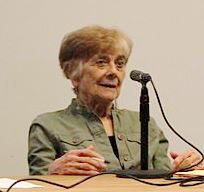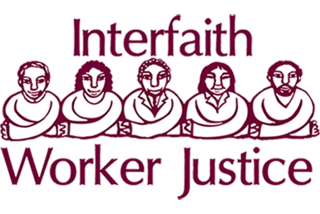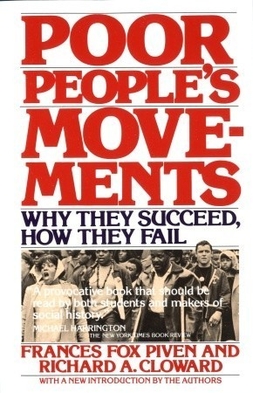The National Council of the Churches of Christ in the USA, usually identified as the National Council of Churches (NCC), is the largest ecumenical body in the United States. NCC is an ecumenical partnership of 38 Christian faith groups in the United States. Its member communions include mainline Protestant, Eastern Orthodox, African-American, evangelical, and historic peace churches. Together, it encompasses more than 100,000 local congregations and 40 million adherents. It began as the Federal Council of Churches in 1908, and expanded through merger with several other ecumenical organizations to become the National Council of Churches in 1950. Its Interim President and General Secretary is Bishop Vashti Murphy McKenzie.
A grassroots movement is one that uses the people in a given district, region or community as the basis for a political or economic movement. Grassroots movements and organizations use collective action from the local level to implement change at the local, regional, national, or international levels. Grassroots movements are associated with bottom-up, rather than top-down decision-making, and are sometimes considered more natural or spontaneous than more traditional power structures.
Stephen Wade Rathke is a community and labor activist who founded the Association of Community Organizations for Reform Now (ACORN) in 1970 and Service Employees International Union (SEIU) Local 100 in 1980. He was ACORN's chief organizer from its founding in 1970 until June 2, 2008, and continues to be chief organizer of ACORN International and United Labor Unions Local 100. He is the publisher and editor-in-chief of Social Policy, a quarterly magazine for scholars and activists. The magazine's publishing arm has published four of his books. He is also a radio station manager of KABF and WAMF.
The Miami Workers Center is a strategy and organizing center founded in 1999 for low-income communities and low-wage workers in the Liberty City neighborhood of Miami, Florida.
The Poor People's Economic Human Rights Campaign (PPEHRC) is a coalition of grassroots organizations, community groups, and non-profit organizations in the United States of America committed to uniting the poor across color lines as the basis for a broad movement to abolish poverty. The PPEHRC seeks to advance economic human rights as outlined in Articles 23, 25, and 26 of the Universal Declaration of Human Rights. These include the rights to education, food, health, housing, communication, and a living wage job.

Richard Andrew Cloward was an American sociologist and activist. He influenced the Strain theory of criminal behavior and the concept of anomie, and was a primary motivator for the passage of the National Voter Registration Act of 1993, commonly known as the "Motor Voter Act". He taught at Columbia University for 47 years.

Frances Fox Piven is an American professor of political science and sociology at The Graduate Center, City University of New York, where she has taught since 1982.

Interfaith Worker Justice (IWJ) was a nonprofit and nonpartisan interfaith advocacy network comprising more than 60 worker centers and faith and labor organizations that advanced the rights of working people through grassroots, worker-led campaigns and engagement with diverse faith communities and labor allies. IWJ affiliates took action to shape policy at the local, state and national levels.
Welfare rights means the rights of people to be aware of and receive their maximum entitlement to state welfare benefits, and to be treated reasonably well by the welfare system. It has been established in the United Kingdom since 1969 and has also been developed in other countries including Ireland, Australia and the United States. It became necessary because of the complexity of the UK social security system and had links at the time with a growing Claimants Union movement. As local authorities realized the advantages of having well-informed front-line staff such as housing officers and social workers, who often have to deal with benefit queries as part of their wider tasks, they turned to welfare rights staff to provide that expertise for both training and handling complex cases. In the 1980s, as local authorities took on the wider 'equalities' agenda, anti-poverty work was seen as a valid local activity in itself. Increasing benefit income helps individuals but also boosts the local economy.
The Direct Action and Research Training Center (DART) is a national network of 23 local faith-based community organizing groups across nine states. DART provides training and consultation for local leaders and professional organizers, giving local communities the skills they need to uncover and take action on pressing local problems. As of 2007, DART is the fourth largest congregation-based community organizing network in the United States.
The Cloward–Piven strategy is a political strategy outlined in 1966 by American sociologists and political activists Richard Cloward and Frances Fox Piven.
The Thomas Merton Center is a non-profit grassroots organization in Pittsburgh whose mission to build and support collaborative movements that empower marginalized populations to advance collective liberation from oppressive systems.

The Unemployed Councils of the USA (UC) was a mass organization of the Communist Party, USA established in 1930 in an effort to organize and mobilize unemployed workers to advance party policy goals in preparation for an anticipated final conflict to overthrow capitalism.

Social movement impact theory is a subcategory of social movement theory, and focuses on assessing the impacts that social movements have on society, as well as what factors might have led to those effects.
The National Union of the Homeless (NUH) is a national union of local activist organizations that fight for housing rights and economic justice in the United States. The organization was active between 1985 and 1993 and was reestablished in 2020. At its height the National Union of the Homeless had over 20 local unions and 15,000 members.
Ruby Phillips Duncan is an activist fighting for welfare rights for the poor in Las Vegas, Nevada. She was also the co-founder of the organization Operation Life and President of the Clark County Welfare Rights Organization.
Johnnie Tillmon Blackston was an American welfare rights activist. She is regarded as one of the most influential welfare rights activists in the country, whose work with the National Welfare Rights Organization influenced the Civil Rights Movement and Dr. Martin Luther King Jr. in particular.

Joseph W. Ellwanger Jr. is a Lutheran pastor, author, and civil rights activist. He was a key figure in the Civil Rights Movement in Birmingham, Alabama, and the only white religious leader included in strategy meetings with Martin Luther King Jr.

Poor People's Movements: Why They Succeed, How They Fail is a book about social movements by the American academics and political activists Frances Fox Piven and Richard Cloward. The book advanced Piven and Cloward's theories about the possibilities and limits of social change through protest. The book uses four case studies: the Unemployed Workers' Movement of the Great Depression, the Industrial Workers' Movement, the Civil Rights Movement, and the Welfare Rights Movement, particularly the activity of the National Welfare Rights Organization.
Premilla Nadasen is an activist and historian, who specialises in the histories of women of colour in the welfare rights movement. She was President of the National Women's Studies Association from 2018 to 2020. She is the author of Welfare Warriors: The Welfare Rights Movement in the United States (2005) and Household Workers Unite: The Untold Story of African American Women Who Built a Movement (2016).







